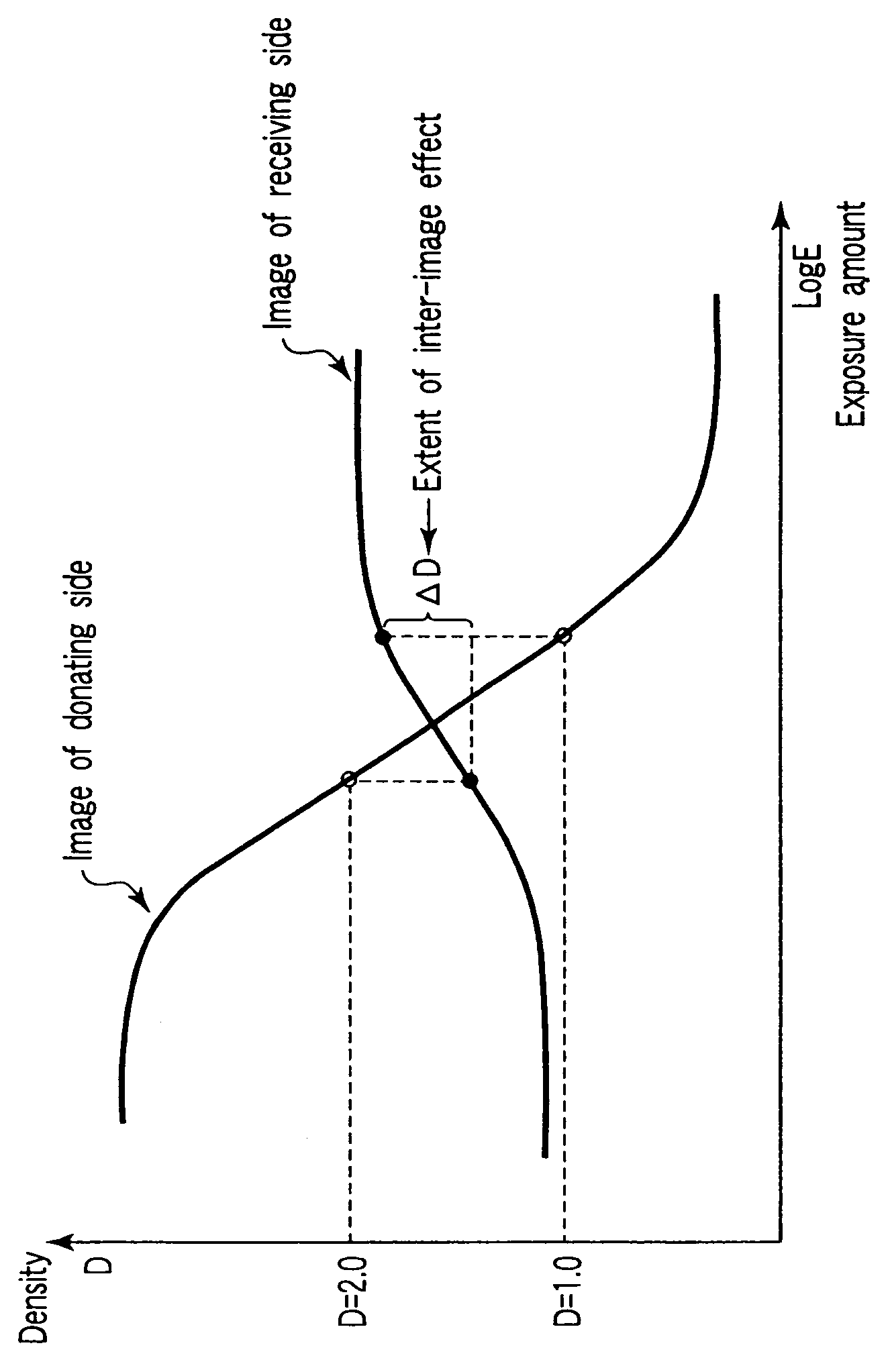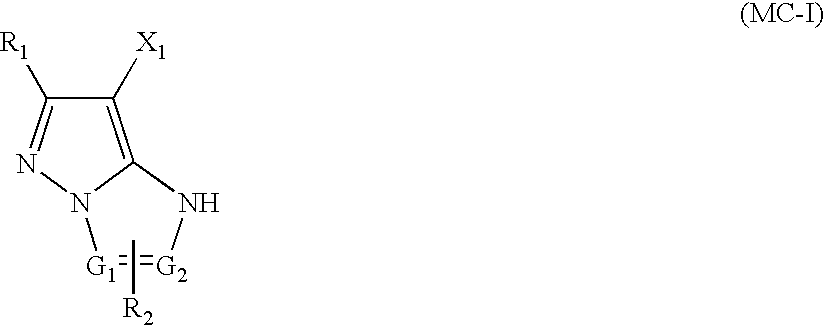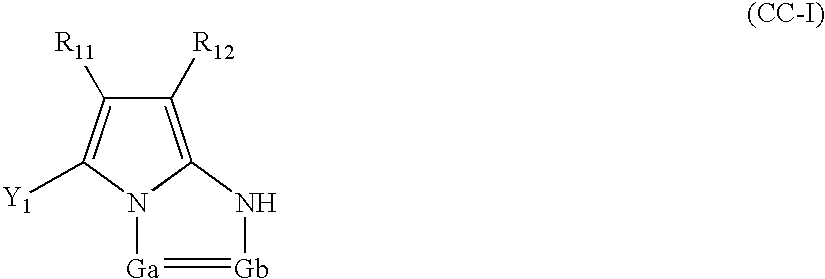[0202]Fine grains contained in the
silver iodide fine grain emulsion may be substantially
silver iodide, and contain
silver bromide and / or
silver chloride only when they can form
mixed crystal. Preferably they are
silver iodide by 100%. As for crystalline structure of silver
iodide, there may be β-phase, γ-phase and, as described in U.S. Pat. No. 4,672,026, α-phase or α-phase homologous structure. In the invention, there is no restriction on the crystalline structure, but a mixture of β-phase and γ-phase, and more preferably β-phase is used. As the silver
iodide fine grain emulsion, those subjected to a normal washing process is preferably used. The silver
iodide fine grain emulsion can be easily formed by the method described in U.S. Pat. No. 4,672,026 and the like. A double-jet addition method of an
aqueous solution of silver salt and that of
iodide salt, in which pI value during grain formation is kept constant, is preferable. Here, pI is logarithm of an inverse number of I−
ion concentration of the
system. There is no particular restriction on temperature, pI, pH, kind and concentration of protective
colloid such as
gelatin, presence or absence and kind and concentration of an
silver halide solvent and the like, but size of grains of 0.1 μm or less, and more preferably 0.07 μm or less is convenient for the invention. Although figure of grains can be not completely specified because the grains are fine, but
coefficient of variation of the grain size is preferably 25% or less. Particularly, when it is 20% or less, effect of the invention is significant. Here, the size and the size distribution of the fine grains are directly obtained by placing them on a mesh for
electron microscope observation and observing them with a transmission method, instead of a carbon replica method. The reason is why observation with the carbon replica method results in a large measurement error because of the small grain size. The grain size is defined as the
diameter of a circle having a
projected area equal to that of the observed grain. Distribution of the grain size is also obtained by using the
diameter of the circle having the equal
projected area. The most effective fine grains in the invention have the grain size
ranging from 0.02 μm to 0.06 μm and the
coefficient of variation of the distribution of the grain sizes is 18% or less.
[0203]After formation of the grains above described, the silver iodide fine grain emulsion is preferably subjected to normal
water washing described in U.S. Pat. No. 2,614,929 and the like, and adjustment of pH, pI, concentration of a protective
colloid agent such as
gelatin and concentration of contained silver iodide. Preferable pH ranges from 5 to 7. Preferably pI value is set the pI value that makes
solubility of the silver iodide minimum, or a value higher than it. As the protective
colloid agent, usual
gelatin with an average molecular weight of 100,000 is preferably used. Low molecular weight gelatin with an average molecular weight of 20,000 or less is also preferably used. Further, a mixture of above described gelatins with different molecular weights is convenient in some cases. Amount of gelatin per kg of the emulsion is preferably from 10 g to 100 g. More preferably, it is from 20 g to 80 g. Amount of silver in terms of silver atom per kg of emulsion is preferably from 10 g to 100 g. More preferably, it is from 20 g to 80 g. It is preferable to select the amount of gelatin and / or silver so that it makes rapid addition of the silver iodide fine grain emulsion suitable.
[0204]Usually, the silver iodide fine grain emulsion is added after it has been previously dissolved, however, stirring efficiency need be made sufficiently high when it is added. Preferably, rotation number of stir is set higher than usual. In order to prevent generation of foam during stir, addition of a defoaming agent is effective. Concretely, a defoaming agent described in Examples and so on of U.S. Pat. No. 5,275,929 is used.
[0205]In the case where the fine grain just after preparation is used, as for details of a mixer for forming the silver
halide fine grain, description in JP-A-10-43570 can be referred to.
[0206]The silver
halide grain according to the invention preferably has a
coefficient of variation of 20% or less for distribution of silver iodide content among the grains. More preferably, it is 15% or less, and particularly preferably, it is 10% or less. The case where the coefficient of variation is larger than 20% is not preferable, since it results in not hard tone and a larger reduction of sensitivity upon pressurization. The content of silver iodide in respective grains can be measured by using an X-
ray micro analyzer and analyzing composition of each of grains. The coefficient of variation for silver iodide
content distribution among grains is a value defined from the relational formula: (standard deviation / average silver iodide content)×100=coefficient of variation, while using the standard deviation of silver iodide content and average silver iodide content when silver iodide content in emulsion grains is measured for at least 100 grains, more preferably for at least 200 grains, and particularly preferably for at least 300 grains. Measurement of the silver iodide content in each of grains is described, for example, in EP 147,868. There are cases where correlation exists and does not exist between silver iodide content Yi (mol %) of respective grains and an equivalent-sphere
diameter Xi (μm) of respective grains, but absence of the correlation is desirable.
[0207]In the emulsions used in the present invention, it is preferable to provide a positive hole-capturing zone in at least a part of the inside of silver
halide grain. The positive hole-capturing zone herein indicates a region having a function of capturing, so to say, a positive hole, for example, a positive hole that arises in pair with a photo-
electron generated by photo-excitation. In the present invention such a positive hole-capturing zone is defined as a zone provide with an intentional reduction
sensitization.
 Login to View More
Login to View More  Login to View More
Login to View More 


